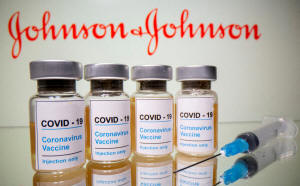Redhill antiviral shows promise in safety study; J&J shot less effective
preventing hospitalization
 Send a link to a friend
Send a link to a friend
 [March 04, 2022]
By Nancy Lapid [March 04, 2022]
By Nancy Lapid
(Reuters) - The following is a summary of
some recent studies on COVID-19. They include research that warrants
further study to corroborate the findings and that has yet to be
certified by peer review.
Redhill drug blocks proteins that help the coronavirus
An experimental oral drug being developed by Redhill Biopharma Inc
interrupts a process that helps the coronavirus infect cells and might
keep COVID-19 patients from becoming seriously ill, the company said.
The virus co-opts proteins in the human body called serine proteases and
uses them to prepare its spike to break into cells and infect them. The
drug, RHB-107, blocks the proteins' activity. The new findings come from
a small trial to confirm the safety of the drug in recently infected,
symptomatic but non-hospitalized COVID-19 patients. While a larger study
is needed to demonstrate efficacy, Redhill in a statement said among the
61 adults in the trial, no one taking once-daily RHB-107 (upamostat)
needed to be hospitalized, compared to 15% of those in a placebo group.
Rates of new-onset severe symptoms were 2.4% with RHB-107 and 20% with
the placebo. Because RHB-107 acts against human proteins that are
involved in preparing the virus spike for cell entry, rather than acting
against the spike itself, the researchers said they expect it could be
effective against new variants despite mutations in the spike.

A larger randomized trial is underway but results are not yet
available. Pfizer's Paxlovid pill, which has emergency use authorization
for patients with early COVID-19, is also a protease inhibitor.
J&J shot less effective against COVID hospitalization
The risk of hospitalization after vaccination with Johnson & Johnson's
COVID-19 vaccine was about five times higher than for those who received
the Pfizer and BioNTech shot, a large French study found.
The study included nearly 7 million recipients of the two-dose mRNA
vaccine from Pfizer/BioNTech and an equal number of similar people who
received the one-shot vector-based vaccine from J&J. The average age was
about 66, and about half were women. By the time half the participants
had been fully vaccinated for at least six weeks, there had been 129
hospitalizations among J&J vaccine recipients versus 23 among the
Pfizer/BioNTech group, the researchers reported on Wednesday in JAMA
Network Open
[to top of second column]
|

Vials with a sticker reading, "COVID-19 / Coronavirus vaccine /
Injection only" and a medical syringe are seen in front of a
displayed Johnson & Johnson logo in this illustration taken October
31, 2020. REUTERS/Dado Ruvic
 Based on their data, they estimated
the effectiveness of the vaccines at preventing hospitalization at
92% for Pfizer's shots versus 59% for the J&J vaccine. "These
results strengthen the evidence" in favor of giving an mRNA booster
shot to people who initially received the J&J vaccine, the authors
conclude.
Experimental vaccine uses spike without sugar-coating
The SARS-CoV-2 virus in lung cells coats itself in sugars produced
by the infected person's body, which help hide parts of the virus
that antibodies could target. A vaccine being tested by researchers
aims to foil that trick by showing the immune system those virus
parts with the sugars stripped away.
By using enzymes in a modified production process, researchers
obtained a coronavirus spike protein without the sugar shields, said
Chi-Huey Wong of The Scripps Research Institute in La Jolla,
California. Unlike current vaccines, a vaccine that shows the entire
uncoated spike to the body would likely be more effective,
stimulating broader responses against variants, because the sugars
disguise the parts of the spike that the variants all have in
common, the researchers said. In mice, the experimental vaccine that
presented the immune system with an uncoated spike "elicited
stronger immune responses and better protection against variants of
concern" compared to vaccines that target the original spike,
according to a report published on Tuesday in Science Translational
Medicine .
Removing the glycan shields to better expose the unmutated parts of
the spike "has the potential to be an effective and simple approach
for developing a broadly protective SARS-CoV-2 vaccine," the
researchers conclude.
(Reporting by Nancy Lapid; Editing by Bill Berkrot)
[© 2022 Thomson Reuters. All rights
reserved.] This material may not be published,
broadcast, rewritten or redistributed.
Thompson Reuters is solely responsible for this content.
 |